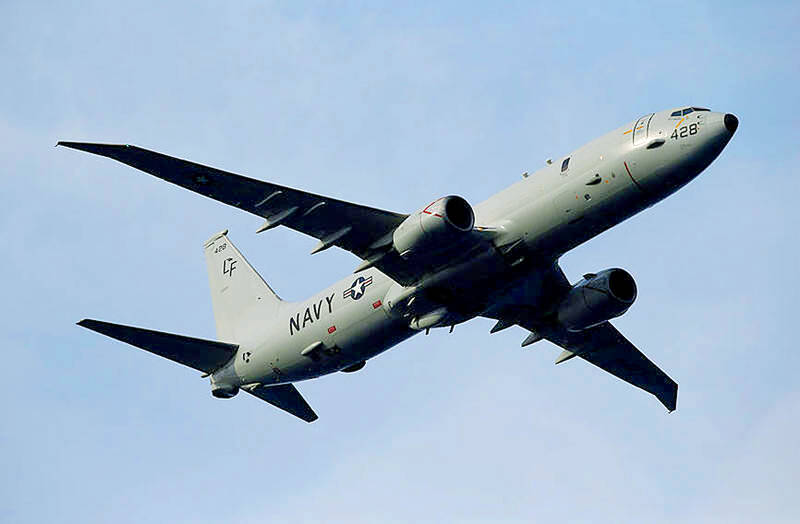A US Navy reconnaissance plane flew through the Taiwan Strait yesterday, days after the nominee to become the next chairman of the US joint chiefs of staff said that under his leadership, the US military would seek more operational bases in the Indo-Pacific region and strive to strengthen Taiwan’s self-defense capabilities.
The Ministry of National Defense said the US aircraft had stuck to the Strait’s median line and flew southward yesterday morning.
The US Navy’s 7th fleet said the P-8A Poseidon maritime patrol and reconnaissance plane, which is also used for anti-submarine missions, flew through the Strait in international airspace.

Photo: Reuters
“By operating within the Taiwan Strait in accordance with international law, the United States upholds the navigational rights and freedoms of all nations,” it said in a statement.
China’s military described the flight as “public hype,” adding that it sent fighters to monitor and warn the US aircraft.
The US flight followed two days of Chinese exercises near Taiwan involving fighters, bombers and warships flying mainly to the nation’s south and out into the Pacific through the Bashi Channel.

Photo: AFP
US Air Force Chief of Staff General Charles Brown Jr said during his confirmation hearing before the US Senate Committee on Armed Services on Tuesday that he would continue to expand the US military’s presence in the Indo-Pacific region, Nikkei Asia reported.
“I’m mindful of the security challenges at this consequential time and the need to accelerate to stay ahead of the growing threat,” he said, referring to China.
He also said that the Pentagon “must implement the national defense strategy and prepare a joint force that can win the next war, if called upon.”

Photo: CNA
“You cannot wait till the crisis occurs to be able to deploy capability,” he added. “You have to preposition capability and have that in place. You have to work with allies and partners to have access to locations.”
Brown said he would prioritize logistics, as the Indo-Pacific region presents more of a challenge in maintaining resupply capabilities, compared with land routes in Europe, the report said.
The confirmation hearing also touched on the issue of granting new authority to the US military to facilitate rapid weapon transfers to Taiwan from US inventories, a move that Brown said would “help [Taiwan] to procure some asymmetric capabilities” for self-defense, the report said.
The general also stressed the value of information gathering and said that the will to fight is a significant factor.
“That’s something that’s hard to measure before a conflict,” but it pays a huge dividend, he said, according to the report.
If confirmed, Brown is to take over from General Mark Milley, who is due to retire in September.
Brown has been a vocal advocate that to respond to crises in the Indo-Pacific region, the US should transition its air forces from large bases to smaller sites spread across the region.
In response to the US Navy’s maneuver, the Chinese military sent 26 aircraft and four naval ships near Taiwan yesterday, with 13 warplanes crossing the median line of the Taiwan Strait, the ministry said.
Ministry data yesterday evening showed that numerous Chinese warplanes were detected throughout the day, including Chengdu J-10, Sukhoi SU-30, Shenyang J-16 and J-11 fighters.

The CIA has a message for Chinese government officials worried about their place in Chinese President Xi Jinping’s (習近平) government: Come work with us. The agency released two Mandarin-language videos on social media on Thursday inviting disgruntled officials to contact the CIA. The recruitment videos posted on YouTube and X racked up more than 5 million views combined in their first day. The outreach comes as CIA Director John Ratcliffe has vowed to boost the agency’s use of intelligence from human sources and its focus on China, which has recently targeted US officials with its own espionage operations. The videos are “aimed at

STEADFAST FRIEND: The bills encourage increased Taiwan-US engagement and address China’s distortion of UN Resolution 2758 to isolate Taiwan internationally The Presidential Office yesterday thanked the US House of Representatives for unanimously passing two Taiwan-related bills highlighting its solid support for Taiwan’s democracy and global participation, and for deepening bilateral relations. One of the bills, the Taiwan Assurance Implementation Act, requires the US Department of State to periodically review its guidelines for engagement with Taiwan, and report to the US Congress on the guidelines and plans to lift self-imposed limitations on US-Taiwan engagement. The other bill is the Taiwan International Solidarity Act, which clarifies that UN Resolution 2758 does not address the issue of the representation of Taiwan or its people in

US Indo-Pacific Commander Admiral Samuel Paparo on Friday expressed concern over the rate at which China is diversifying its military exercises, the Financial Times (FT) reported on Saturday. “The rates of change on the depth and breadth of their exercises is the one non-linear effect that I’ve seen in the last year that wakes me up at night or keeps me up at night,” Paparo was quoted by FT as saying while attending the annual Sedona Forum at the McCain Institute in Arizona. Paparo also expressed concern over the speed with which China was expanding its military. While the US

SHIFT: Taiwan’s better-than-expected first-quarter GDP and signs of weakness in the US have driven global capital back to emerging markets, the central bank head said The central bank yesterday blamed market speculation for the steep rise in the local currency, and urged exporters and financial institutions to stay calm and stop panic sell-offs to avoid hurting their own profitability. The nation’s top monetary policymaker said that it would step in, if necessary, to maintain order and stability in the foreign exchange market. The remarks came as the NT dollar yesterday closed up NT$0.919 to NT$30.145 against the US dollar in Taipei trading, after rising as high as NT$29.59 in intraday trading. The local currency has surged 5.85 percent against the greenback over the past two sessions, central